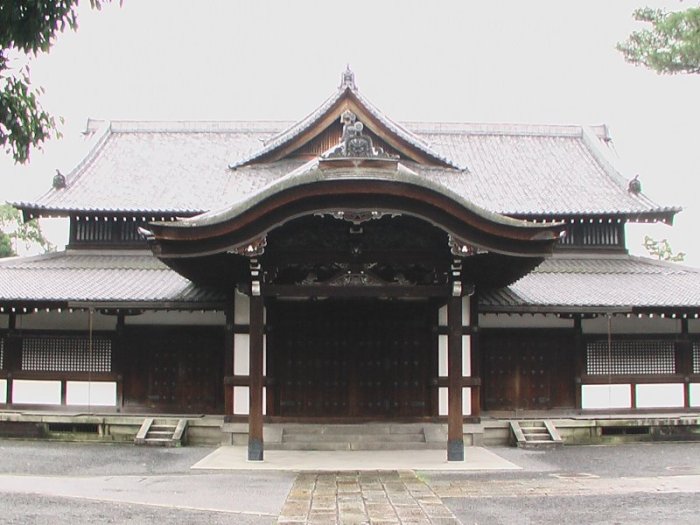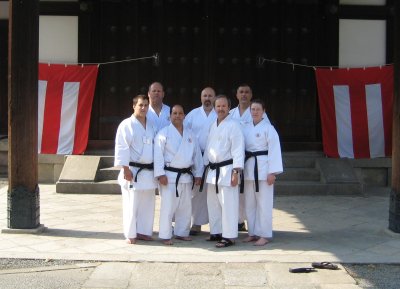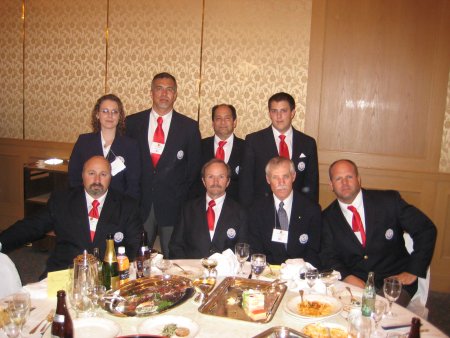A BRIEF REFLECTION: KARATE KA
by Sensei Fa Jue

Kyoto is nice this time of the year. Not too cold and wet - and not too warm and humid. It's mostly T-Shirt weather with a light jacket handy.
The uniform for those participating in the Dai Nippon Butoku Kai's World Butoku Sai was the official windbreaker over the dogi. We walked as a group, in typical Japanese fashion, to and from the world renown Butokuden, a building over 1200 years old which boasts a history rich with tales of famous and not so famous Samurai as well as such 20th century Budoka as Chojun Miyagi, Sensei and founder of Goju-Ryu Karate-Do.
Our daily schedules were pretty hectic, beginning at 7:AM and ending around 10:PM; although there was some limited time alloted for sight-seeing. It had been nearly 30 years since I last visited Japan, and much had changed. In the 70’s, the country was going through a transition in dress. The elderly and even some of the middled aged wore traditional "old-Japan" attire. The younger population dressed in contemporary western clothing. Now, there was no sign of the old-dress styles to be found. All were dressed in the fashions typical of any western city.
Additionally, we didn't have to travel far to see KFC, Pizza Hut, Circle K, 7-11, McDonalds, and, happily, STARBUCKS! Those of us in real estate got a kick out of seeing a house for sale with a “Century 21” sign in front of it. While meals were included in our tour-package, many weren’t ready for the Japanese style Bento Lunches served three times a day or for the other traditional Japanese meals served most every night, the presentation of which seemed more important than the flavor. Our team brought a lot of business to the 24 Hour McDonalds just a few blocks away. (Brandon Wainwright, Bakersfield GKK Dojo, would have camped out in their lobby after the second day of Japanese food, which he simply could not bring himself to eat.)
I expected many things from this trip: jet lag; hard training; good training; new friends; frustrations with language; and all things that an American martial artist might encounter on such a trip. But as I sat on the tatami mats that surround the Butokuden training floor, I experienced an unexpected feeling of awe. It suddenly hit me that this was the same floor that Chojun Miyagi, one of the greatest Karate-Ka of all time, stood on and demonstrated the skill that resulted in Karate-Do being accepted and established as a Japanese Budo. With that thought still resonating in my mind, I heard one of the directors of the event tell me to get my team ready to enter the Butokuden floor.
As we stepped onto the polished hardwood, we could somehow feel centuries of warrior spirits encourage and empower us as we, too, performed for the Hanshi board of the DNBK and Deputy Sosai, the official representative of the Imperial Family.

Each delegation of the 1100 participants from all over the world was given 5-7 minutes on two separate days to demonstrate its respective arts. My team from the Goju-Ryu Karate-Do Kyokai (GKK) demonstrated Saifa Kata and Bunkai (Application) on the first day, and Seiunchin Kata and Bunkai on the second day. Alone, I also demonstrated Seisan Kata and Sepai Kata on the first day and Shisochin Kata and Kururunfa Kata on the second day. We received numerous compliments on our demonstrations, and I was quite proud of the team’s performance.
We were privileged to watch demonstrations from countries around the globe, including many middle and far eastern states. I was honored to meet Mr. Ron Kluger, Goju-Ryu Hachi-Dan from Israel. Additionally, at one of our many dinner banquets, I was seated next to Mr. Ken Tallack Goju-Ryu Hachi-Dan from Canada. Kyoshi Tallack, who speaks fluent Japanese, shared his vast knowledge of information about the DNBK. The delegation from the Honbu (Headquarters) of the DNBK in Japan was everything one would expect. However, the International Division was equally impressive and included Kendo from the U.K. and Jujutsu from Russia.
As I watched the performances of students from so many different countries, I couldn't help but notice how similar their demeanor was. The awareness of Martial Virtues was dynamically present - these were the virtues and relative protocols that distinguish the DNBK. Presentation is everything. Proper politeness and courtesy abound. When to bow and how to bow. When to applaud and how to applaud. How to enter and leave a room. A place for everything and everything in its place. A rigorous attention to big things and to little things. Did you know, for example, that when eating a meal with your instructor, that: 1) You do not order before Sensei, 2) You do not eat before Sensei, 3) You do not leave the table before Sensei. Right down to the very last detail, there is a proper protocol for the way all things are done. For the OCD (obsessive-compulsive disordered) among us, this was heaven.
I should note that the method of instruction is always one of compassion and gentle guidance. No one is chastised for improper behavior but is politely shown the proper way.

Each of the GKK students who attended this event with me is to be commended. I was very proud of every one of them. While the protocols were not new to me, for them it was all a part of a very new experience which they received in a way that brought credit to the GKK, making it worthy to be called Budoka. GKK members who attended with me were Robert DaLessio, Brandon Wainwright, Greg Rader, Christian Rader, Chris Duarte, and Ilea Jackson.
There is much more that I could write about the events we experienced on our trip. However, as I think about what was most important, I’m reminded of what Kyoshi Ken Tallack said at dinner one evening. “I may not like your waza (technique),” he said, “but that is not important”. He then reached over and tapped me on the chest, “It’s what’s in here that is important.” Kyoshi Tallack had explained the essence of the Dai Nippon Butoku Kai (Greater Japan Martial Virtue Society).
I am extremely humbled and forever grateful to Dr. Tesshin Hamada, Hanshi (International Division Director) for his invitation to participate in this most prestigious event.
